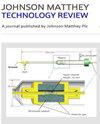Centralised and localised hydrogen generation by ammonia decomposition
IF 2
4区 化学
Q4 CHEMISTRY, PHYSICAL
引用次数: 2
Abstract
Ammonia is a strong candidate as a hydrogen vector and has the flexibility to be used directly as a fuel or decomposed to form pure hydrogen. The format of an ammonia decomposition plant is only starting to emerge, with two types becoming significant: centralised locations feeding into the national gas network, and decentralised units, to supply fuelling stations, the chemical industry, or remote applications. In this paper, we review the aspects critical to decompose ammonia in both cases. While the centralised cracking flowsheet can use equipment standard to current hydrogen production methods, the localised cracking unit requires a more innovative design. Energy and safety considerations may favour low temperature operation for decentralised applications, requiring high activity catalysts, whilst centralised industrial sites may operate at higher temperatures and use a base metal catalyst. Purification to deliver hydrogen suitable for fuel cells is one of the biggest challenges in developing the flowsheet.通过氨分解集中和局部制氢
氨是一个强有力的候选氢载体,具有直接用作燃料或分解成纯氢的灵活性。氨分解工厂的形式才刚刚开始出现,其中两种类型变得重要:集中的位置为国家天然气网络提供服务,分散的单元为加油站、化学工业或远程应用提供服务。在本文中,我们回顾了在这两种情况下分解氨的关键方面。虽然集中式裂化流程可以使用当前制氢方法的标准设备,但局部裂化装置需要更具创新性的设计。能源和安全方面的考虑可能有利于分散应用的低温运行,需要高活性催化剂,而集中式工业场所可能在更高的温度下运行,并使用贱金属催化剂。为燃料电池提供氢气的净化是开发流程的最大挑战之一。
本文章由计算机程序翻译,如有差异,请以英文原文为准。
求助全文
约1分钟内获得全文
求助全文
来源期刊

Johnson Matthey Technology Review
CHEMISTRY, PHYSICAL-
CiteScore
4.30
自引率
4.30%
发文量
48
审稿时长
12 weeks
期刊介绍:
Johnson Matthey Technology Review publishes articles, reviews and short reports on science enabling cleaner air, good health and efficient use of natural resources. Areas of application and fundamental science will be considered in the fields of:Advanced materials[...]Catalysis[...][...]Characterisation[...]Electrochemistry[...]Emissions control[...]Fine and speciality chemicals[...]Historical[...]Industrial processes[...]Materials and metallurgy[...]Modelling[...]PGM and specialist metallurgy[...]Pharmaceutical and medical science[...]Surface chemistry and coatings[...]Sustainable technologies.
 求助内容:
求助内容: 应助结果提醒方式:
应助结果提醒方式:


